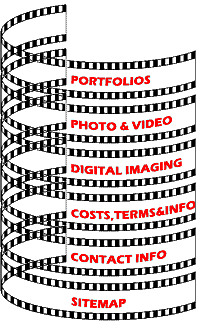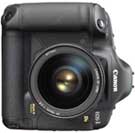 |
Digital or Film?
"Dollar for dollar no
other capture device can match the information density of film" |
|
|
>>
Architectural
|
The
future is finally upon us and we have gone "All Digital." For those that
prefer film for what ever reason we still retain all of our film
capabilities too. The articles below, with updates illustrate the transition
to today's all digital photography and may be of interest to you to read. To
see the precise differences between film and digital both pro and con please
follow this new link, which may help you understand and decide what is best
for your job; PROS & CONS Digital versus Film point by point This article below was written in 1999, please also see periodic updates at the bottom. The most recent is a long detailed reply to a short question (04/07): Last year [1998] I lost a job because the first and last question a printer's rep asked me was "do you have a digital camera?" In that case his client had instructed him to find a photographer with a digital camera and there was no way of reasoning past that. At that time we had no digital cameras. This may seem strange since over 95% of what I shoot becomes digital once I scan it, manipulate and tweak it on the computer and output it to a digital printer, film-writer, inkjet or press ready file. Why don't I have a digital camera? |
|
| The digital revolution is upon us and I
have fully embraced the convergence of the technologies that this has allowed. You may
have noticed from this site the diversity of products and services we offer, all because
of this convergence. It not a far step to create a web site, layout an ad or brochure or
even make a video once the elements are scanned and accessible to the tools a computer
offers and combined with some sound design principles. But only recently have I
entertained the idea of obtaining a digital camera. Here is why. |
||
| Dollar for dollar no other capture
device can match the information density of film. Film is cheap. And it is ideal for
"data acquisition". This is because I can shoot a subject from a variety of view
points and at a later date determine which was the most ideal composition and exposure for
a given purpose. You may argue that you can do the same with a digital camera and here is
where the truth comes out. A digital camera which is fast enough the capture and store
multiple images will offer such a low density of information i.e. file size, resolution,
detail, etc. that it is very limited in what it can do. Images cannot afford to be cropped
and can only be used within very limited size restrictions. Additionally the images from
these cameras suffers from compressed contrast, that is the shadows are darker and the
highlights are lighter than film or your eye can detect, much like a video camera. |
||
| Now
cameras are available which overcome this limitation. They record so much information that
several are in fact superior to film. Yes, amazing as that sounds, they actually can
record more information and produce larger higher resolutions than most any film. But the
current trade off is that they are relatively large, need to be directly connected to a
computer, are somewhat slow as they must save all of this information and here's the
killer, they cost tens of thousands of dollars. There are sound applications for these
devices, but not within my client base. Even worse, their prices are only going down, but
not fast enough. It's the old paradox, it's cheaper if you can afford to wait. Don't buy a
computer now, wait ten years, they'll be way faster and way cheaper then they are now. Soon the prices on this level of
digital camera will fall into a sensible range. In the meantime the quality of the
consumer and "prosumer" products is quickly reaching up to meet them. Film will
indeed be around for a few more years. At this time it is still the best value I can offer
my clients. We back up on to CD-R all of our scans and digital files, but even more economical is my file system which contains all of the film from the jobs that I've shot in the last 12+ years. Give me a job number or date and I'll find the shot in 2minutes or less. Last year we did invest in a digital video system and upgraded our workstations to edit the results. This camera also shoots digital stills and so I now have a digital camera. This year we purchased a high-end film scanner so we can bring our scans in-house. The new scanner produces nearly 100Mb files from the medium format film we use on most jobs. This results in higher quality and lower prices for our clients. I will likely buy a high-end "prosumer" digital camera this coming year as well. The benefit will most likely fit shots for planning shoots, comps, and product shots that we know are going to be used on a smaller scale. So we, like many imaging professionals are in a state of transition, where various issues and concerns must be weighed. In the end we will use what offers the best value and highest quality to best suit our clients needs. More important than deciding
whether you are for or against digital cameras is to recognize where they currently fit
best in the process. From there it will be a slow but steady migration to an all digital
world. But don't give up on film just yet.
Thanks for your compliment. In
response to your question; it all depends on what you are trying to
do. "As good" is too simple in that you can buy a car for $15K or
$150K. Is the more expensive one better because it costs more? Maybe
not for towing, or gas mileage or a host of other things. The cost
of the best digital systems are quite a bit more than film cameras.
The 1Ds MkII cost about $8000
when it came out and requires Canon's best lenses to realize it's
full potential. A film camera only needs to allow you to change it's
settings, be somewhat durable and function reliably and as such can
be much cheaper to buy, but it also requires film and film must be
processed. Did you get the shot? Have to wait and see, that's if the
lab doesn't damage the image. So the question is more complicated
than it may first appear.
Making a 40x80 mural that appears
photographic, whether from film or digital involves a number of
things. One of my printers outputs at only 80dpi (Kodak
DS1000, which is a
rebadged postscript
HP755CM), yet appears
photographic at about 18", that
is you don't see the dots. I've sold literally hundreds of 30x40
murals produced on this printer as well as many other sizes, as
small as 20x24 and as large as 36x96. A higher resolution digital
printer produces a more detailed print, especially when compared
with this 80dpi model side by side. The 40x80 may not be a single
photo but may incorporate several photos plus graphics, text and the
like, making the resolution of any single image less important. A
stark, graphic image may appear sharper than a highly textural,
detailed subject (imagine a sunset
backlighting a landscape vs.
shots of flowers lit in midday for example). And as you suggest the
viewing distance is also a factor. Do you know how low resolution
most billboards are? Where the
image displayed is a factor in that you can't walk up to most
billboards, but you might get
close to a floor the ceiling image displayed at the airport for
example.
The 2500dpi printer I currently use (HP130nr) outputs files typically that originate at 300-400ppi (pixels per inch) and they look as photographic as any chemical process print. That printer uses 6 color inks. The 80dpi uses only 4. I have just ordered a new 44" 12 color printer (HP Z3100) which also outputs at 2500dpi (1200x2500 actually). Once I have it I will do tests of various images at differing resolutions to see what degradation occurs as I drop the resolution (or artificially bump it up) for a variety of subjects including black and white.
To compare digital to film you should
consider several factors as well.
MegaPixels is just part of the equation to digital just as
the type of film shot is as important as the format. Different
sensors differ in the results they produce. Factors here include the
sensor size, photo imaging sites (the pixels in
megapixels) as well as their
position and spacing relative to each other. Even how the file is
filtered and processed within the camera is important. Then consider
the quality and resolving power of the lenses used (also the
enlarging lens if the print from film is not digital). For a digital
print made from film the scan is also very important.
At this point in the art my
conclusions are that a quality
sensor in a professional grade digital camera system using the best
lenses exceeds the quality of 35mm film (including
Kodachrome) at around 8MP (MegaPixel) systems.
My Canon 1Ds Mk II is superior in
my opinion to the medium format
(120/6x6cm) images I was producing with my
Hasselblad system on 100 ISO
negative film and scanning with a Nikon
Super Coolscan 800ED (4000dpi).
Would a transparency film scanned by a quality drum scanner compare
to the Canon? Probably, but another factor for me is that I do not
need to buy, test, store, protect from heat, process, scan and
store processed film. Nor do I have to invest the expense as well as
the time in driving back and forth to labs for film processing nor
scans (I have 4 scanners in-house), nor prints for that matter (I
will have my 6th onsite print
shortly).
Are current digital systems
comparable to 4x5 or possibly
8x10 size film? I have access to a 39MP digital back that I can use
on my Hassy or 4x5 kit. It is
said to be superior in resolution to what you can do with most 4x5
films. I have even seen a huge digital camera that shoots something
like 1000MP (GigaPixel)!, but the
type of work I do for what my
clients pay me cannot justify the additional expense or trouble of
even the 39MP system. If I were working for a big agency on a big
account with lots of people looking of my shoulder all too happy for
the process to be more complicated and more expensive then perhaps,
but that's not what I do right now.
I shoot
industrial and architecture
plus a little food, product and some executive portraits. I moved
away from 4x5 to medium format because I could produce more decent
shots faster and cheaper, knowing
that I would be able to scan the film and correct perspective in
Photoshop. I used
primarily medium format, scanning
my own film since Kodak introduced the 72Mb ProPhoto
CD scan for around $20. Then I
bought a tray mounted 2500dpi
flatbed scanner for around $5000, which lead to the
Nikon scanner that I paid
around $3000 for. This all started in the early '90s when the
scanning technology was far ahead of the digital camera technology.
I bought my 1Ds
MkII as soon as it was available.
It was the first camera I felt produced an image of suitable quality
for me to stop shooting film. Canon is expected to release the next
generation of the camera late this year (November?). It's
rumored to be around 22MP,
smaller and offer a sensor cleaner of some sort. At this point,
while I imagine I will likely buy one of these, I don't see the need
to get it the first day it's available. Additional resolution is
always useful and the sensor cleaner is probably even more useful,
but what I'm working with now works fine for what I do.
The short answer to your question is that I have not yet made a 40x80 from a file from my 1Ds MkII as yet [04/07, waiting to receive and test new Z3100 printer], but I hope to soon. If you're interested I'll let you know how it turns out. I hope you find my reply complete if long. Followup 11/07: Now that I've been using our new Z3100 printer for about 6 months I can report that it has well exceeded my expectations. I have printed a variety of image subjects on Photo Glossy, Photo Matte, Clear Film, Backlit Material & 100% Rag (cotton) Art Paper. The results are stunning. I am able to load small sheets of paper and print as small as a single 5x7 or as large as 44"x96" full bleed! A shot I made of a Porsche 911 Turbo featuring the red brake calipers for Brembo shot with my 16.7mp Canon 1Ds MkII looks spectacular! At any distance the grain/noise is very low, the neutral tones (it's a gray car to make the red brakes pop visually) are absolutely neutral and the color (sky, brakes, logo) are vivid. I am very pleased and am now printing over 95% of my outputs on this printer.
please click here to read more about the Digital
Studio. |
||
So what's your view? Let me know. Proshooter@gmail.com |
||
|
Additional "Useful Articles" can be found on the
Sitemap page. |

